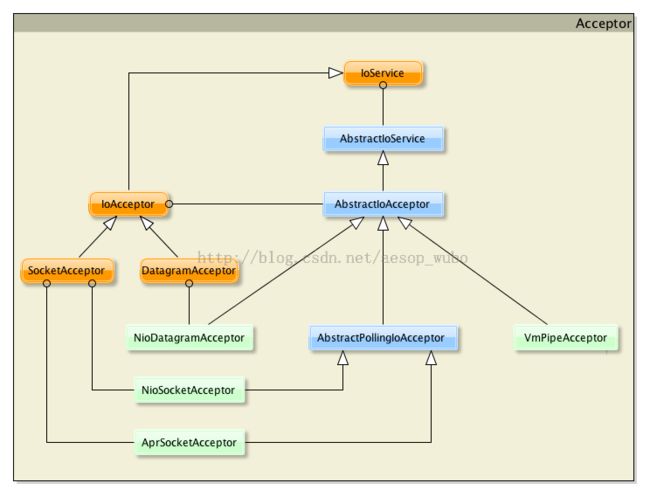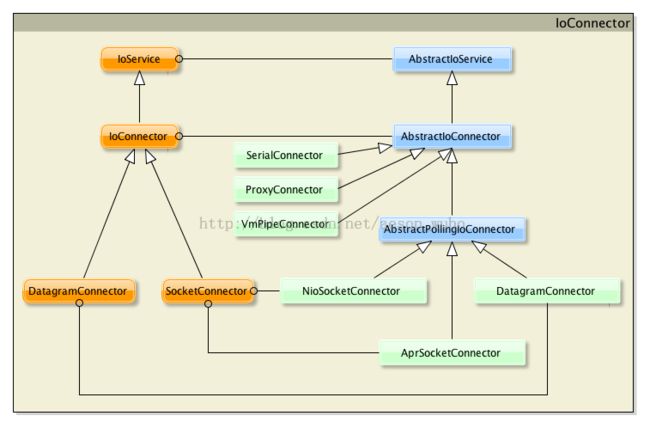Apache Mina IoAcceptor与IoConnector
简介
Apache mina是一个介于应用程序与网络之间的NIO框架,它使程序员从繁琐的网络操作中解脱出来,花更多的时间在业务处理上。
如下图所示,mina分为三层
1、IOService层:处理IO操作
2、IOFilter层:过滤器链,日志处理、字节变换、对象转换等操作
3、IOHandler层:真正的处理业务逻辑的地方
IOService层根据不同的角色又分为IOAcceptor和IOConnector,分别用于接受连接与请求连接操作。
IOAcceptor
上图是IOAcceptor的类图,IOAcceptor相当于是对ServerSocketChannel的封装,最重要的两个操作是绑定与接受连接,IOService接口中有多个重载的bind方法
public interface IoAcceptor extends IoService {
void bind() throws IOException;
void bind(SocketAddress localAddress) throws IOException;
void bind(SocketAddress firstLocalAddress, SocketAddress... addresses) throws IOException;
void bind(Iterable<? extends SocketAddress> localAddresses) throws IOException;
}
其方法的实现在抽象类AbstractIOAcceptor的bind方法中,这个方法在做了参数检查等操作后,将真正的绑定操作交给抽象方法bindInternal来完成。对于bindInternal有基于TCP/IP,UDP/IP,VMPipe三种实现,以TCP/IP为例来看绑定过程
protected final Set<SocketAddress> bindInternal(
List<? extends SocketAddress> localAddresses) throws Exception {
// Create a bind request as a Future operation. When the selector
// have handled the registration, it will signal this future.
AcceptorOperationFuture request = new AcceptorOperationFuture(
localAddresses);
// adds the Registration request to the queue for the Workers
// to handle
registerQueue.add(request);
// creates the Acceptor instance and has the local
// executor kick it off.
startupAcceptor();
// As we just started the acceptor, we have to unblock the select()
// in order to process the bind request we just have added to the
// registerQueue.
wakeup();
// Now, we wait until this request is completed.
request.awaitUninterruptibly();
if (request.getException() != null) {
throw request.getException();
}
// Update the local addresses.
// setLocalAddresses() shouldn't be called from the worker thread
// because of deadlock.
Set<SocketAddress> newLocalAddresses = new HashSet<SocketAddress>();
for (H handle:boundHandles.values()) {
newLocalAddresses.add(localAddress(handle));
}
return newLocalAddresses;
}
主要干了以下几件事情:
1、将绑定请求放入registerQueue中
2、启动Acceptor,从Acceptor类的run方法可以看到,这一步会阻塞在Acceptor选择器的选择操作中
3、调用wakeup让选择器返回
4、等待请求处理完成,这一步会阻塞在ready变量中,当ready变量为true时才会返回,当接受连接后ready会被设置为true.
现在重点看一下Acceptor的run方法
public void run() {
......
while (selectable) {
try {
int selected = select();
nHandles += registerHandles();
if (nHandles == 0) {
acceptorRef.set(null);
if (registerQueue.isEmpty() && cancelQueue.isEmpty()) {
assert (acceptorRef.get() != this);
break;
}
if (!acceptorRef.compareAndSet(null, this)) {
assert (acceptorRef.get() != this);
break;
}
assert (acceptorRef.get() == this);
}
if (selected > 0) {
processHandles(selectedHandles());
}
// check to see if any cancellation request has been made.
nHandles -= unregisterHandles();
} catch (...) {
...
}
// Cleanup all the processors, and shutdown the acceptor. set ready=true
}
(1)、selector被wakeup唤醒后,调用registerHandles方法从registerQueue中取出请求依次调用open方法
protected ServerSocketChannel open(SocketAddress localAddress)
throws Exception {
// Creates the listening ServerSocket
ServerSocketChannel channel = ServerSocketChannel.open();
boolean success = false;
try {
// This is a non blocking socket channel
channel.configureBlocking(false);
// Configure the server socket,
ServerSocket socket = channel.socket();
// Set the reuseAddress flag accordingly with the setting
socket.setReuseAddress(isReuseAddress());
// and bind.
socket.bind(localAddress, getBacklog());
// Register the channel within the selector for ACCEPT event
channel.register(selector, SelectionKey.OP_ACCEPT);
success = true;
} finally {
if (!success) {
close(channel);
}
}
return channel;
}
open方法完成了ServerSocket的绑定和注册
(2)、从(1)中可以知道selector上注册了ServerSocketChannel的OP_ACCEPT键,注册后nHandles==0,selected==0,进行下一次循环,同样是阻塞在select方法上
(3)、当连接到来时,select方法返回,selected>0,执行processHandles方法
private void processHandles(Iterator<H> handles) throws Exception {
while (handles.hasNext()) {
H handle = handles.next();
handles.remove();
// Associates a new created connection to a processor,
// and get back a session
S session = accept(processor, handle);
if (session == null) {
break;
}
initSession(session, null, null);
// add the session to the SocketIoProcessor
session.getProcessor().add(session);
}
}
该方法在完成真正的接受连接操作后,创建session并扔到processor中,后续的工作交给processor来完成。每个session中其实有一个SocketChannel,这个socketChannel实际上是被注册到了processor的selector上。注册代码在NioProcessor类中可以找到
protected void init(NioSession session) throws Exception {
SelectableChannel ch = (SelectableChannel) session.getChannel();
ch.configureBlocking(false);
session.setSelectionKey(ch.register(selector, SelectionKey.OP_READ,
session));
}
整个Acceptor的实现就讲解完了,总结一下:Acceptor线程专门负责接受连接,在其上有一个selector,轮询是否有连接建立上来,当有连接建立上来,调用ServerSocketChannel.accept方法来接受连接,这个方法返回一个session对象,然后将这个session对象加入processor中,由processor遍历每个session来完成真正的IO操作。processor上也有一个selector与一个Processor线程,selector用于轮询session,Processor线程处理每个session的IO操作。
IOConnector
IOConnector的类图如下:
IOConnector的设计与IOAcceptor几乎完全一样,唯一不同的是与Acceptor线程对应的是Connector线程,在完成连接操作后也是扔了一个session对象到Processor中。
关于Processor与Session后续再分析......


